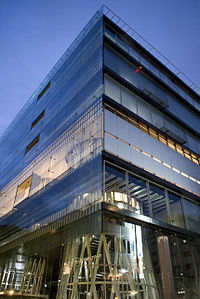Toyo Ito | |
|---|---|
 Ito, at a lecture in April 2009. | |
| Born | 1 June 1941 |
| Nationality | Japanese |
| Occupation | Architect |
| Awards | Pritzker Prize (2013) |
| Practice | Toyo Ito & Associates |
| Website | www |


Toyo Ito (伊東 豊雄, Itō Toyō, born 1 June 1941) is a Japanese architect known for creating conceptual architecture, in which he seeks to simultaneously express the physical and virtual worlds. He is a leading exponent of architecture that addresses the contemporary notion of a "simulated" city, and has been called "one of the world's most innovative and influential architects."[1]
In 2013, Ito was awarded the Pritzker Prize, one of architecture's most prestigious prizes.[2] He was a likely front-runner for the Pritzker Prize for the previous 10 years. A recent trend has seen less experienced and well-known winners, for example Chinese architect Wang Shu in 2012, and the award to Toyo Ito is seen as recognition of a lifetime's achievement in architecture.[3]
Ito was born in Seoul, Korea to Japanese parents on 1 June 1941 when Korea was under Japanese rule. In 1943, he moved to Japan with his mother and two sisters living until middle school age in rural Shimosuwa, Nagano Prefecture. Ito attended Hibiya High School in central Tokyo and graduated from the University of Tokyo's department of architecture in 1965.[4]
After working for Kiyonori Kikutake Architect and Associates from 1965 to 1969 (alongside Itsuko Hasegawa), in 1971 he started his own studio in Tokyo, named Urbot ("Urban Robot"). In 1979, the studio name was changed to Toyo Ito & Associates.[4]
Throughout his early career Ito constructed numerous private house projects that expressed aspects of urban life in Japan. His most remarkable early conceptual contributions were made through projects of this scale, such as White U (1976) and Silver Hut (1984).[1]
With the Pao for the Tokyo Nomad Girl projects in 1985 and 1989, Ito presented a vision of the life of an urban nomad, illustrative of typical lifestyles during the bubble economy period in Japan.[5]
Tower of Winds (1986) and Egg of Winds (1991) are interactive landmarks in public spaces, resulting from a creative interpretation of contemporary technical possibilities.[1] Whilst their function is in fact exhaust air outlets for the underground system below, their significance lies in Ito's treatment of their opacity, one of the hallmarks of his work. Whilst appearing solid during the day, the perforated aluminium structures "dissolve" at night through the use of computer-controlled light systems which form an interactive display representing measured data such as noise levels in their surrounding vicinity.
Toyo Ito's office is known as a training ground for talented younger architects. Architects who previously worked for his office include Kazuyo Sejima and Ryue Nishizawa (SANAA), Astrid Klein and Mark Dytham (KDa), Katsuya Fukushima, Makoto Yokomizo, and Akihisa Hirata.[6]
Ito's work is often said to have affinities with the ideas of philosophers such as Munesuke Mita and Gilles Deleuze.
Ito has defined architecture as "clothing" for urban dwellers, particularly in the contemporary Japanese metropolis. This theme revolves around the equilibrium between the private life and the metropolitan, "public" life of an individual.
The current architecture of Toyo Ito expands on his work produced during the postmodern period, aggressively exploring the potentials of new forms. In doing so, he seeks to find new spatial conditions that manifest the philosophy of borderless beings.
Ito's work has been exhibited widely. In 1991, Ito used 130 video projectors to simulate the urban environment of Tokyo for the Visions of Japan exhibition at The Victoria and Albert Museum in London.[7] Later, in 2000, his Vision and Reality at the Louisiana Museum of Modern Art also became a traveling exhibition.[8] Ito similarly exploited the effect of video projection as a medium with which to exhibit architecture in his Blurring Architecture exhibition, initiated at the Suermondt-Ludwig-Museum in Aachen and traveling to four other cities (Tokyo, Antwerp, Auckland, and Wellington between 1999 and 2001).[9]
Ito designed the Berlin-Tokyo/Tokyo-Berlin Exhibition (2006) at the Neue Nationalgalerie, Berlin. The design featured a smooth, undulating landscape that occupied almost the entirety of the museum's main exhibition space. This exhibition, in collaboration with the Mori Art Museum, was one of the largest undertakings in the museum's history.[10] A major retrospective of Ito's work was shown at the Tokyo Opera City Art Gallery in 2006 as Toyo Ito: The New "Real" in Architecture.[11]
Source:[12]
Ito's awards and honors include:
Ito holds a professorship at the Japan Women's University. He is also an honorary professor at the University of North London and has served as guest professor at Columbia University. He teaches at Tama Art University Graduate program as a professor.[22]